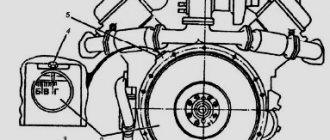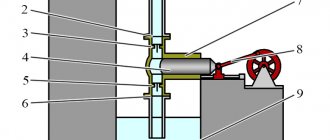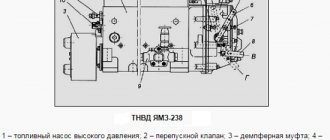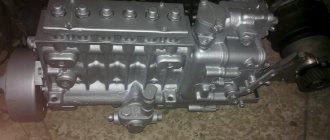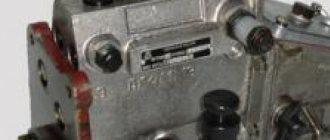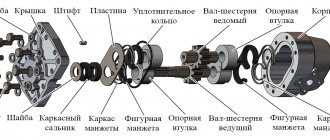The popularity of diesel engines is steadily growing, which is explained by the obvious advantages of this type of power plant. One of the most important parts of the unit is the injection pump or high pressure fuel pump. It is the operation of this unit that largely determines the operating efficiency of the entire diesel engine.
Therefore, it is not surprising that increased attention is always paid to the adjustment, maintenance and repair of fuel injection pumps. The requirements and rules for organizing these important technological processes are discussed in this article.
What is fuel injection pump and its types
The high pressure fuel pump is responsible for the timely supply of the required amount of diesel fuel to the combustion chamber.
A feature of a diesel engine is the need to pump high pressure, which is required for self-ignition of the fuel, which is also one of the important tasks of the fuel injection pump. The basic unit of the injection pump is a plunger pair, consisting of a liner and a piston moving inside it. Depending on the design features, there are three main types of high-pressure fuel pumps installed on diesel engines: in-line, distribution and main. The latter option is used especially often today, as it is used in Common Rail fuel supply systems. Despite significant differences in design, power and dimensions, there are general rules that should be followed when adjusting, maintaining and repairing high-pressure fuel pumps for diesel engines.
Controlling the moment when fuel supply starts
VAZ-2106, main brake cylinder operating principle, design, repair
The moment the fuel supply begins is regulated by a closed-loop electronic control system (feedback control system). An injector needle movement sensor installed in one of the injectors (usually in the first cylinder) sends a signal to the electronic control unit about the actual moment of fuel injection. This information is used to determine the actual injection start point in degrees of rotation of the engine crankshaft, which in turn can then be compared with the setting value of this value and subsequent adjustment is made according to the electrical signal sent to the fuel start actuator.
The actuator (drive) for starting fuel supply is “structurally rigid”. For this reason, you can dispense with a special feedback sensor. Structural rigidity means that the directions of action of the forces of the electromagnet and the spring always have a precisely defined point of intersection, that is, these forces are always in equilibrium. Thus, the linear movement of the electromagnet armature is proportional to the strength of the electric current, which is equivalent to the action of feedback in a closed-loop control system.
Rules for carrying out work on adjusting fuel injection pumps
Before proceeding to a direct description of the stages of adjusting the injection pump, it is necessary to note several important rules that are recommended to be followed when organizing this technological process. In this case, we are talking about the following recommendations from experienced and professional mechanics:
· The fuel injection pump is rightfully considered a responsible unit. This means that it is simply not worth changing its settings unnecessarily;
· the second important consequence of the above rule is that the adjustment of the high-pressure fuel pump should be done using appropriate equipment, preferably on a special stand;
· it is allowed to independently perform only the simplest work on adjustment, maintenance and repair of high-pressure fuel pumps;
· all settings of such a complex mechanism as fuel injection pump are interconnected. Therefore, changing one parameter may negatively affect other performance characteristics. This is another argument in favor of contacting specialists who have a sufficient level of knowledge and experience to correctly adjust the fuel pump.
Compliance with the listed fairly simple and obvious rules will minimize the risk of unprofessional actions when adjusting the injection pump and, as a consequence, serious financial expenses necessary for its subsequent repair.
Main stages of fuel injection pump adjustment
As noted above, special stands are used to adjust the injection pump. The work is divided into two main stages. At the first of them, the cyclic fuel supply is regulated, and at the second, the so-called UONP or the advance angle of the start of fuel supply into the combustion chamber is adjusted. In addition, during the adjustment process, as a rule, several more maintenance operations are performed on the injection pump - removing air trapped in the injection system, lubricating pump parts and assemblies, and, if necessary, preparing for shutdown for a long time. Each of the described adjustment stages requires more detailed consideration.
Cycle feed adjustment
The purpose of this type of adjustment is to determine the optimal mode of fuel supply in terms of quantity and uniformity into the combustion chamber. Changing the settings is carried out by adjusting the position of the fuel injection pump rack, which is done using a special screw. For single-plunger pumps, a doser is used for this instead of a rack.
Until recently, cyclic feed control was carried out using glass graduated tubes installed on a test bench. Modern equipment allows adjustment using a display that displays all the necessary data, which significantly simplifies the adjustment procedure and makes it more accurate and efficient.
Adjustment of UOP
This stage of the technological process is also carried out on special stands. As additional equipment, a momentoscope is used, which is a glass tube with an attached high-pressure hose. It is installed on one of the sections of the diesel engine. The adjustment procedure is quite complex and requires appropriate professional skills and experience working with such high-precision and complex equipment.
Removing air from the injection system
Air trapped in the high-pressure fuel injection system can significantly reduce the overall efficiency of the diesel engine or even make it impossible. Most often, a similar situation occurs when replacing any pump parts, for example, a fuel filter, or after a long-term cessation of operation of the unit. In any of these cases, air is removed either using a hand pump, the presence of which is provided for by the design of the fuel injection pump, or automatically using a flow valve installed on the fuel filter.
Lubrication
Most diesel engines have a single lubrication system for the fuel injection pump and the power unit. In such a situation, the high pressure fuel pump is essentially maintenance-free and does not require any additional intervention. The main requirement is to maintain the functionality of the overall lubrication system.
If the engine design does not provide for the presence of such a system, lubricating oil should be poured into the injection pump through the cover, having first removed the cap from it. The oil level must be regularly monitored: if there is excess, it is drained, if there is a deficiency, on the contrary, it is topped up. When carrying out major repairs, the old lubricant must be replaced.
Preparing for an extended outage
In case of prolonged non-use of the diesel engine, it is recommended to preserve the fuel injection pump. To do this, about 10% of a special anti-corrosion compound is added to the fuel in the fuel tank and to the oil in the camshaft chamber. Then you need to start the engine for a quarter of an hour, as a result of which ordinary diesel fuel and lubricant will simply be washed out of the high-pressure fuel pump, and the composition that replaced them will reliably protect components and parts from corrosion, and the fuel from thickening.
Start of fuel supply
Device repair and adjustment of carburetor for 151C
As soon as the plunger (position 7) completes the preliminary stroke h1, the control clutch 4 closes the control hole 6 in the plunger. From this moment, the pressure inside the high-pressure chamber 2 increases, and geometric fuel supply begins.
The moment at which the supply and, consequently, fuel injection begins, changes with the vertical movement of the control clutch relative to the plunger. When the control clutch is closer to the position of the plunger at TDC, the stroke of the plunger until the control hole 6 is blocked is greater, and the start of feed, therefore, occurs later, and when the control clutch is located closer to the BDC of the plunger, the stroke of the plunger until the hole is blocked is shorter, and the geometric the start of the feed occurs earlier.
The shape of the injection pump cam determines the stroke speed of the plunger and, accordingly, the nature of the fuel supply (theoretical amount of fuel supplied per degree of rotation of the injection pump camshaft), as well as the fuel injection pressure.
The most common malfunctions due to incorrect adjustment
It is recommended that adjustment and maintenance of fuel injection pumps be carried out regularly at specialized stands with the participation of professional mechanics. The frequency of the procedure depends on several factors, including: engine brand and power, intensity of operation, quality of diesel fuel used, etc.
The following signs of malfunction of the power unit and its individual components may be the basis for extraordinary adjustment and, if problems are identified, repair of the fuel injection pump and the diesel engine as a whole:
· engine operation with interruptions and differences in power. As a rule, problems in this case are associated with the supply of fuel in portions of different volumes. To eliminate them, competent adjustment of the fuel injection pump is required and, if the malfunction was not identified in a timely manner, repair;
· sharp decrease in engine power. The main cause of the problem is usually untimely injection of fuel into the combustion chamber. As a result, fuel ignition occurs with a noticeable delay and the fuel is not completely burned, which leads to the appearance of soot in the exhaust gases and a general drop in the efficiency of the unit. If a problem is identified at an early stage, adjustment of both the cyclic feed and the OHP is required. Otherwise, expensive repairs with possible replacement of the main working unit of the fuel injection pump are necessary;
· leakage or excessive fuel consumption. This problem often becomes a consequence of accelerated wear of components and mechanisms of the fuel injection pump and the engine as a whole, which is caused by poor fuel quality. It is possible to eliminate or minimize the malfunction only at the initial stage. With further use of substandard fuel, repair and, quite possibly, replacement of the fuel injection pump or its main parts will be required;
· extraneous noise during startup and further operation of the unit. There are various reasons for the occurrence of sounds uncharacteristic of normal engine operation. In order to determine the nature of the malfunction, it is necessary to carry out full maintenance and diagnostics of the unit, including the injection pump. After eliminating the problems, the high pressure fuel pump must be adjusted.
Other methods of bleeding the fuel system of a diesel engine
So, above we looked at the main way to bleed a diesel fuel system.
At the same time, many specialists and experienced car enthusiasts separately point out that in some cases such attempts to bleed the pump can have serious consequences for the power system. Please note that the reason for this concern is that if there is mechanical damage, bleeding in this manner can cause irreparable damage. Let's look at other existing methods
First of all, the bolt on the fuel return line (the so-called “return”) is loosened. Next, you should carefully monitor how the fuel comes out. If air bubbles are visible, then this means that the system is airy.
If so, you can use a simple tire inflator or compressor. Next, the hose is removed from the fuel pump and the air pump hose is installed in its place. The basic idea is that pumping occurs, which allows the pressure in the system to increase. This pressure makes it possible to pump diesel fuel into the fuel pump.
So, first the fuel filter is removed and its housing is dried. Then the individual elements are wiped, then reassembled. Next you will need to locate two fittings on the filter housing. One of the fittings is needed for draining diesel fuel, and the other is suitable for pumping.
Having prepared the vacuum cleaner, you also need a regular medical syringe and a hose 30-40 cm long. For these purposes, it is recommended to use a transparent type of hose. The syringe is inserted into the hose, and the other end of the hose is put on the bleeder fitting.
Next, the piston is pulled out of the syringe, and the vacuum cleaner tube is inserted into the syringe. The main thing is to achieve reliable fixation and a tight fit. Also, the joints can be sealed by putting on pieces of hoses of different diameters, winding electrical tape, etc.
Now you can unscrew the fitting a little, after which the vacuum cleaner turns on. After a few seconds, yellowish foam can be seen in the syringe. This is a mixture of diesel fuel and air. Further pumping comes down to ensuring that the syringe is filled with clean diesel fuel instead of foam.
Let's consider another solution that allows, in some cases, to quickly pump the diesel fuel system. To do this, it is enough to completely fill the fuel filter housing with diesel fuel, after which the engine starts. Next, you need to let the engine run at high speeds, as a result of which the power system is pumped.
Injection pump repair
Despite the obvious advantages, the operation of a diesel engine is accompanied by certain disadvantages. Among the most significant of them is the difficulty of self-diagnosis and repair of the power unit. In other words, everything said above about adjusting the injection pump is also true in relation to its maintenance and repair.
That is why it is necessary to regularly contact specialized service or repair centers that have both the necessary modern equipment and specialists who can effectively use it in practice. This approach, with a relatively low level of financial costs, will ensure long-term and trouble-free operation of the diesel engine in general and the injection pump in particular. In addition, timely and professional adjustment and maintenance of the power unit will not only save money on more expensive repairs, but will also allow you to fully use the numerous and obvious advantages of modern diesel engines.
Adjusting and repairing the high pressure fuel pump - process features
The need to repair the fuel injection pump can be caused by several reasons. The most common of them are considered to be the following:
- Pump wear. It is easy to determine by such phenomena as loud and uneven operation of the engine, difficulty starting it when hot, and loss of power.
- Use of low quality diesel fuel. Fuel is used for moving parts of high-pressure fuel pumps as a lubricant. If it includes certain impurities (particles of dirt, drops of gasoline or water), its lubricating capabilities are reduced, which causes the pump to fail.
- Incorrect operation of electronic devices installed on the vehicle.
When repairing fuel injection pumps, it is most often necessary to replace worn parts, and this can only be done by disassembling the device. In principle, performing repair work yourself is not so difficult if you arm yourself with knowledge about the structure of the fuel pump, as well as a set of special tools (vise, gas wrench, tweezers, set of hexagons and sockets, calipers, screwdriver). But experts always recommend trusting them to service stations and car repair shops.

